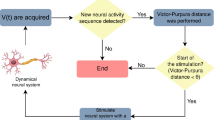Abstract
Simultaneous electrical stimulation and recording are used to gain insights into the function of neuronal circuitry. However, artifacts produced by the electrical stimulation pulses prevent the recording of neural responses during, and a short period after, the stimulation duration. In this work, we describe a mixed-signal recording topology with template subtraction for removing the artifact during the stimulation pulse. Emulated artifacts generated from a lumped electrical circuit model and experimental artifacts in cardiac cell cultures are used to evaluate the topology. The simulations show that delays between the emulated artifact and its estimated compensation template represent the largest error source of the analog template subtraction. The quantization error appears like random noise and determines the threshold level for the action potential detection. Simulations show that removal of the artifacts is possible, allowing the detection of action potentials during the stimulation pulsing period, even for high-amplitude saturating artifacts. Measurement results with artifacts elicited in cardiac cell cultures show feasible applications of this topology. The proposed topology therefore promisingly opens up a previously unavailable detection window for improving the analysis of the neuronal activity.








Similar content being viewed by others
References
Andersen VO, Buchthal F (1970) Low noise alternating current amplifier and compensator to reduce stimulus artefact. Med Biol Eng Comput 8:501–508
Bernabid A, Pollak P, Gao D, HOffmann D, Limousin P, Gay E, Payen I, Benazzouz A (1996) Chronic electrical stimulation of the ventralis inter-medius nucleus of the thalamus as a treatment of movement disorder. J Neurosurg 84(2):203–214
Blum R, Ross J, Brown E, DeWeerth S (2007) An integrated system for simultaneous, multichannel neuronal stimulation and recording. IEEE Trans Circuits Syst I Reg Papers 54(12):2608–2618. doi:10.1109/TCSI.2007.906071
Brown E, Ross J, Blum R, Nam Y, Wheeler B, DeWeerth S (2008) Stimulus-artifact elimination in a multi-electrode system. IEEE Trans Biomed Circuits Syst 2(1):10–21. doi:10.1109/TBCAS.2008.918285
Brug GJ, Eeden ALGVD, Sluyters-Rehbach M, Sluyters JH (1984) The analysis of electrode impedances complicated by the presence of a constant phase element. J Electroanal Chem 176:275–295
Ferris CD, Stewart LR (1974) Electrode-produced signal distortion in electrophysiological recording systems. IEEE Trans Biomed Eng BME-21(4):318–326 doi:10.1109/TBME.1974.324319
Fuentes R, Petersson P, Siesser WB, Caron MG, Nicolelis MAL (2009) Spinal cord stimulation restores locomotion in animal models of parkinson’s disease. Science 323(5921):1578–1582
Gnadt J, Echols S, Yildirim A, Zhang H, Paul K (2003) Spectral cancellation of microstimulation artifact for simultaneous neural recording in situ. IEEE Trans Biomed Eng 50(10):1129–1135 doi:10.1109/TBME.2003.816077
Hashimoto T, Elder CM, Okun MS, Patrick SK, Vitek JL (2003) Stimulation of the subthalamic nucleus changes the firing pattern of pallidal neurons. J Neurosci 23:1916–1923
Hashimoto T, Elder CM, Vitek JL (2002) A template subtraction method for stimulus artifact removal in high-frequency deep brain stimulation. J Neurosci Methods 113:181–186
Heffer LF, Fallon JB (2008) A novel stimulus artifact removal technique for high-rate electrical stimulation. J Neurosci Methods 170:277–284
Hua Y, Lovely DF, Doraiswami R (2006) Factors affecting the stimulus artifact tail in surface-recorded somatosensory-evoked potentials. Med Biol Eng Comput 44:226–241
Martin M, Lasia A (2011) Influence of experimental factors on the constant phase element behavior of pt electrodes. Electrochim Acta 56:8058–8068
Murmann B Adc performance survey 1997–2012. http://www.stanford.edu/murmann/adcsurvey.html
Musa S (2011) Design, fabrication, and characterization of a neural probe for deep brain stimulation and recording. Ph.D. thesis, Katholieke Universiteit Leuven
Nguyen T, Braeken D, Musa S, Krylychkina O, Bartic C, Gielen G, Eberle W (2010) Towards a closed-loop system for stimulation and recording: an invitro approach with embryonic cardiomyocytes. In: Proceedings of the 32nd Annual International Conference of the IEEE Engineering in Medicine and Biology Society (EMBC 2010), pp 2735–2738
Nguyen T, Eberle W, Musa S, Bartic C (2008) A hybrid stimulation artifact reduction scheme for microfabricated deep brain stimulation and recording probes. In: 13th Annual Conference of the International Functional Electrical Stimulation Society
NI-Developer-Zone (2010) Tutorials—timing and synchronization features of ni-daqmx http://www.ni.com/white-paper/4322/en
Parsa V, Parker P, Scott R (1998) Convergence characteristics of two algorithms in non-linear stimulus artefact cancellation for electrically evoked potential enhancement. Med Biol Eng Comput 36:202–214
Rosin B, Slovik M, Mitelman R, Rivlin-Etzion M, Haber SN, Israel Z, Vaadia E, Bergman H (2011) Closed-loop deep brain stimulation is superior in ameliorating parkinsonism. Neuron 72:370–384
Venkatraman S, Elkabany K, Long JD, Yao Y, Carmena JM (2009) A system for neural recordings and closed-loop intracortical microstimulation in awake rodents. IEEE Trans Biomed Eng 56:15–22
Wagenaar DA, Pine J, Potter SM (2004) Effective parameters for stimulation of dissociated cultures using multi-electrode arrays. J Neurosci Methods 138:27–37
Wagenaar DA, Potter SM (2002) Real-time multi-channel stimulus artifact suppression by local curve fitting. J Neurosci Methods 120:113–120
Wichmann T (2000) A digital averaging method for removal of stimulus artifacts in neurophysiologic experiments. J Neurosci Methods 98:57–62
Acknowledgments
This work has been funded in part by the Flemish Government (IWT SBO grant BrainStar). The authors thank Dr. Dries Braeken (Imec) for helping with the cardiac cell cultures.
Author information
Authors and Affiliations
Corresponding author
Rights and permissions
About this article
Cite this article
Nguyen, T.K.T., Musa, S., Eberle, W. et al. Mixed-signal template-based reduction scheme for stimulus artifact removal in electrical stimulation. Med Biol Eng Comput 51, 449–458 (2013). https://doi.org/10.1007/s11517-012-1013-6
Received:
Accepted:
Published:
Issue Date:
DOI: https://doi.org/10.1007/s11517-012-1013-6




